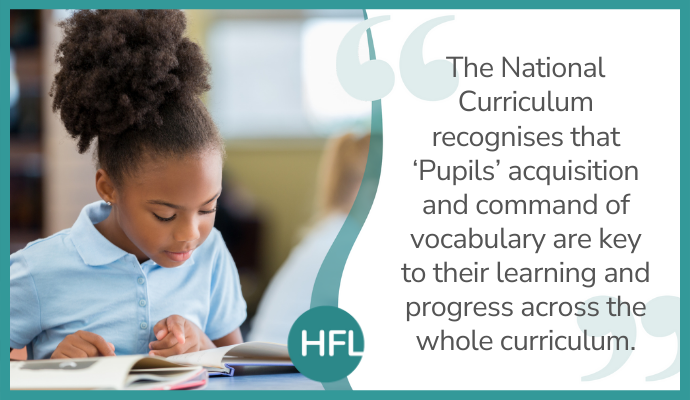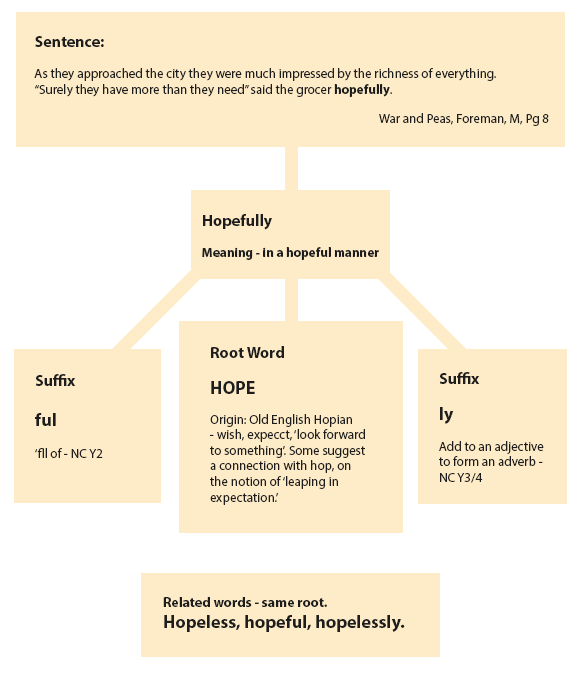
With our Word-Utopia English conference just a few weeks away, language and vocabulary are very much at the forefront of our minds. The varied line-up of speakers - including academics, poets, authors and teachers - will present us all with a fresh look at how to support language acquisition in the classroom. But, there’s no need to wait until after the conference to get stuck into vocabulary work with your class. Join us as we revisit this blog from our former colleague, Sabrina Wright, about how we can develop children’s vocabulary through morphemic analysis.
The National Curriculum recognises that ‘Pupils’ acquisition and command of vocabulary are key to their learning and progress across the whole curriculum.’ Acquiring a broad vocabulary supports understanding in all subjects. Understanding is developed through language comprehension, and the exploration and explicit teaching of new vocabulary contributes to pupils’ developing comprehension.
‘Vocabulary is learnt both indirectly and directly. Children learn the meanings of most words indirectly, through everyday experiences with oral and written language.’ (Armbruster, Lehr, & Osborn, 2011). Wider reading is an absolutely essential part of indirect vocabulary growth; however, it is not sufficient for all students. For children to have a deep and long-lasting understanding of the vocabulary they are learning they need to meet the words they come across frequently, and in different contexts. In other words, it is not enough to look a word up in a dictionary and expect that most children will be able to understand it, use it and apply that word in other contexts. They need more to be able to build a sense of the word. So, if dictionaries won’t do the job, we need to provide children with word learning strategies and knowledge that they can apply independently. In addition to this, it is vital that we inspire children to develop an interest and love of words, their meanings and how they are built.
‘Simply put, if we want our students to become independent word learners, then we must model how to think about new words that they encounter in their reading.’(Templeton & Pikulski, 1999)
Templeton and Pikulski (1999) talk about there being ‘four types of knowledge and strategies that enable students to become independent word learners:
- morphological knowledge
- effective use of contextual clues
- the application of morphological and contextual knowledge in a word-learning strategy
- the role of dictionaries and other word reference books.
Research has shown that being able to draw upon specific morphemic elements, and how these combine to make words, supports students in being able to determine the meaning of new words. (Scott & Nagy, 1994). With that in mind, I’d like to fly the flag for using morphological knowledge to support the acquisition of new vocabulary, and to consider the important part it plays.
So what is morphology?
Morphological knowledge is the spelling of grammatical units within words (e.g. horse = 1 morpheme, horses = 2 morphemes). It includes knowledge about the following: root words, compound words, suffixes, prefixes and the origins of words (etymology).
The National Curriculum sets out that students begin with the exploration of morphemic elements in KS1, with base words and suffixes such as adding -s/-es/-ing/-ed/-ful/-ly, and by the time they get to KS2, not only are they exploring a wider range of prefixes and suffixes, but they can begin to explore in detail the morphology of a variety of words, and use this to help their understanding of new vocabulary.
For example, knowing bicycle (Year 3/4 statutory word list NC) is cycle from the Greek for wheel, with bi– meaning ‘two’ before it, and in Year 5/6 knowing conscience and conscious (Y5/6 statutory word list NC) are related to science: conscience is simply science with the prefix con- added (these words come from the Latin word scio meaning ‘I know’), helps children to understand not only the meaning of the vocabulary being taught, but they can then later apply this knowledge to any new related vocabulary.
So how can I use morphology to support word learning in the classroom?
Basically, this strategy focuses on analysing the meaningful parts (morphemes) within in a word to support the understanding of it.
Kieffer and Lesaux (2007) suggested the following steps for effective teaching of morphemic analysis:
- teach morphology in the context of rich, explicit vocabulary instruction;
- teach students to use morphology as a cognitive strategy with explicit steps;
- teach underlying morphological knowledge in two ways—both explicitly and in context.
The following graphic shows an example of how you would analyse a word with pupils as part of the above model.

Being explicit with the children that words that are related in meaning are often related in spelling, and that clues to the structure of the words can be clues to the meaning, is essential in supporting children in their vocabulary acquisition.
As touched on before, it is also important that teachers share with children their own interest in and enthusiasm for words, and model how they’ve thought about them. Sharing an interesting story about where a word originates from can help to develop an interest and curiosity in words. For example, I should probably tell you about the origin of the word vocabulary, but honestly I’d rather tell you about the origin of the word nincompoop. The day I got my etymology dictionary, ‘Nincompoop’ was the first word I was thumbing through the pages looking for. Curious? It turns out that there are a few stories about its origin; one is from the 17th century, where it is suggested it originates from a ‘given name Nicholas or from Nicodemus…and his naive questioning of Christ’, but the other (and my favourite) although denied by some etymologists, is from the 1670s where it was linked to the Latin legal phrase ‘non compos mentis’. How does that help me you may ask yourself? Well, I don’t use the word nincompoop often, but it certainly has stuck in my mind, and I can see how the definition is linked to its origin. What would be the first word you would look up?
There have been a number of studies that show the significant relationship between vocabulary and comprehension, and another factor to consider is that the ‘teaching of morphological awareness and decoding in school may be the way to narrow the achievement gap for children whose families differ in education and income levels, and ethnic or racial backgrounds.’ (Nagy 2007). Morphemic analysis is just one strategy of many, but it is a valuable strategy to aid word learning that will help readers unlock the meaning of new and challenging words with increasing independence.
Originally published 15 June 2016 by Sabrina Wright, who was previously an English Teaching and Learning Adviser for HFL Education.
Bibliography
Armbruster, B., Lehr, F., & Osborn, J. (2001). Put reading first: The research building blocks for teaching children to read.
Kieffer, M. J., & Lesaux, N. K. (2007). Breaking down words to build meaning: Morphology, vocabulary, and reading comprehension in the urban classroom.
Nagy, W. (2007). Metalinguistic awareness and the vocabulary‑comprehension connection.
In R. K. Wager, A. E. Muse, & K. R. Tannenbaum (Eds.), Vocabulary acquisition: Implications for reading comprehension.
Scott, J. A., & Nagy, W. E. (1994). Vocabulary development. In Purves, A. C., Papa, L., & Jordan, S. (Eds.), Encyclopedia of English studies and language arts, Vol. 2.
Templeton, S. & Pikulski, J. (1999) Building the Foundations of Literacy: The Importance of Vocabulary and Spelling Development. Houghton Mifflin Company.
Recommendations
Oxford Dictionary of Word Origins (Oxford Quick Reference) Cresserrl, J. (2010)


